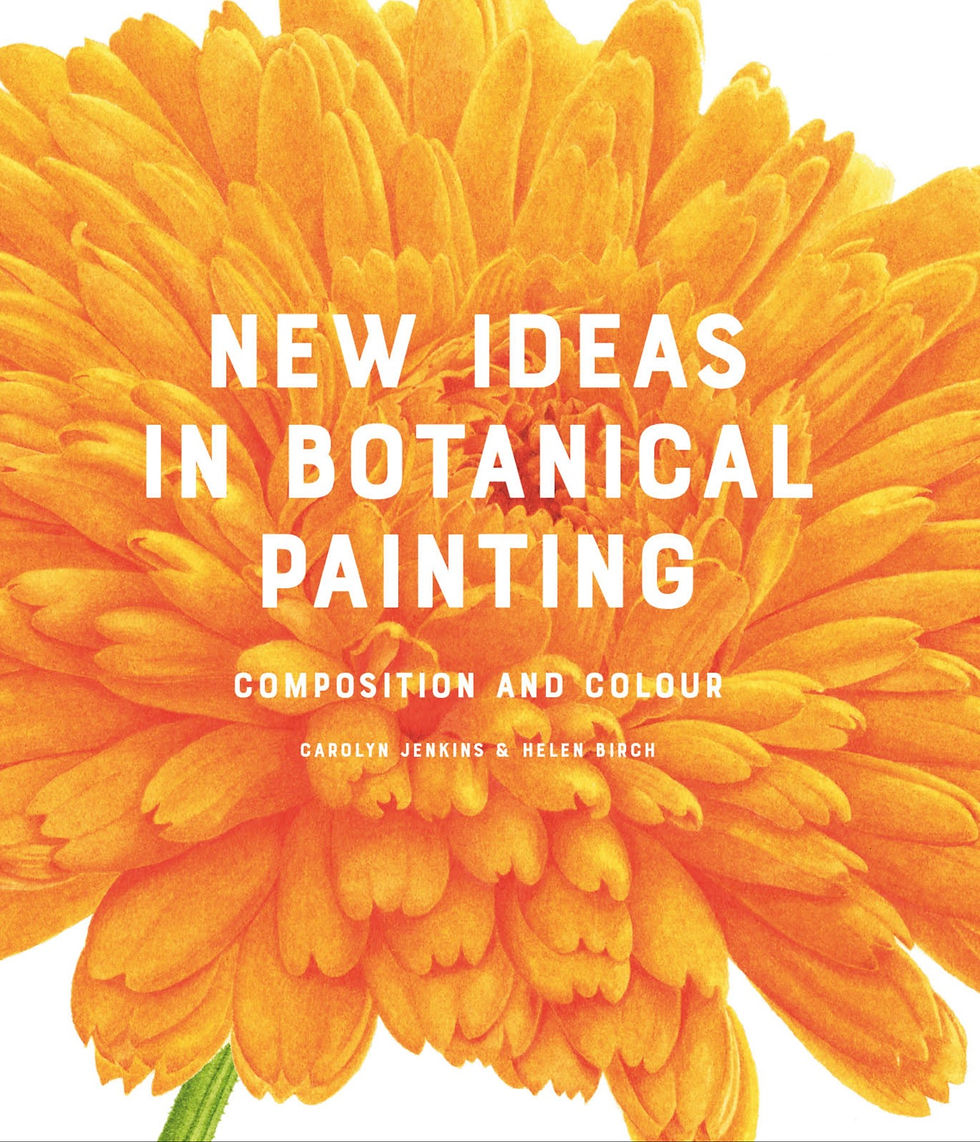New Ideas in Botanical Painting: Composition and Colour by Carolyn Jenkins and Helen Birch
- Mary Crabtree
- May 6, 2023
- 4 min read
With an art form as old as botanical painting, it’s exciting to see this tradition enjoying a moment in the sun. This book provides a refreshing look at the subject, making this type of art relevant to the contemporary world. Emma van Klaveren looks at Carolyn Jenkins’ and Helen Birch’s book, published by BT Batsford Ltd in 2022, with Carolyn’s gorgeous images and engaging text by Helen.
Review by Emma van Klaveren - botanical artist and ABA Committee and Education Team member.

They say don’t judge a book by its cover but how could I resist this exquisite one displaying an enormous marigold! I have to confess that I have always been a super fan of Carolyn Jenkins’ work, so reviewing this sumptuous book was a treat. This tactile hardback is split into just three sections, so it’s not overwhelming and it is bursting with luscious illustrations. Carolyn said: ‘Batsford Books approached me to do the book and I think they have done a really good job with the design. I was rather terrified by the thought and it was a lot of work even though I didn’t write it but I was so flattered to be asked. I was initially very against using the marigold picture for the cover but I think it turned out to be a very good choice and works really well.’
The Introduction describes how Carolyn has come to this point in her work. This fascinated me - her artistic family, her education and training and her passion for gardening. She describes how she began to earn a living from her illustration and to ‘get work as a freelance illustrator in advertising and graphic design, often illustrating packaging for well-known brands’ which is a big area of interest for me. She also comments on the difference between botanical art and botanical illustration which is often confused. I feel Carolyn brings this art form into the twenty-first century by brilliantly straddling the two.

The first and second chapters are simply entitled ‘Grow’ and ‘Paint’. At the end of the day that is what it boils down to when capturing plants. I was interested to read about her top artistic inspirations: Church, Bauer and McEwen plus the Indian Company of Artists. Carolyn’s expertise and passion for growing and painting in the UK and France is key to her capturing of botanical subjects and their anatomy. I really appreciated the information she supplies on where she gets her subject matter, namely, she grows it. This has inspired me to buy a coldframe and to start improving my gardening skills from scratch! If the plant required is something more unusual or out of season she will find a photo on the internet, look in other people’s gardens, contact a florist or have a look in London’s Covent Garden Market. She also describes her fascination with dissection, inspired by the Victorian botanist and painter Arthur Harry Church, another area I need to work on! Additionally, this section sees Carolyn describing how the seasons influence her work alongside her use of different lighting sources (natural and artificial). Finally, her equipment is detailed in a flat lay which is always interesting to me so I can compare my own selection and see if there is anything I could add.

The second chapter, ‘Paint’, delves into subject choices, textures, colour, composition, and background colour. Realistic greens and challenging white flowers are also addressed, something most botanical artists need to work on. Photoshop and photography have influenced her composition and working methods too. Using photographs as a reference in the botanical world is often frowned upon so I was glad to see a different take on this. Sometimes it is simply not possible to get hold of a specimen, a commercial commission is required ‘yesterday’ or one doesn’t have time to spend hours in the field because of school pickup! Carolyn said: ‘Use of the camera and computer screen are intrinsic parts of my practice. I find the highly detailed nature of my work means that working from life needs to be supported by sequences of photographic and digital backup.’

Another favourite part of the book was learning more about the wide variety of Carolyn’s commissions, how social media enhances her profile and her agent who deals with the negotiation of contracts, invoicing and the all-important fees. I find information on this area seems to be rarer than hens’ teeth in the botanical community.
If you’re looking for a step-by-step, how-to guide, this is not the book for you. However, this beautiful book is stuffed full of great advice for every aspect of being a contemporary botanical artist. It’s the perfect combination of practical painting advice using old methods and modern technology from this RHS gold medal-winning artist with text by Helen Birch.
This review is completely independent of the authors and publisher and the book was not gifted.
Author Biographies
Carolyn Jenkins is a professional gardener and renowned botanical artist. She studied art and graphic design at St.Martin’s School of Art in London and Bath Academy of Art and received a Distinction for her diploma in Botanical Painting at The English Gardening School. She has won two RHS medals for her botanical paintings. Her paintings are held by the RHS Lindley Library in the UK and The Hunt Institute for Botanical Documentation in the US and she has illustrated for The Sunday Times Magazine and many other publications, advertisements, and private commissions. www.carolynjenkins.co.uk Instagram: @carolynjenkins
Helen Birch is the author of several drawing and painting publications including Just Draw Botanicals. She is also an art tutor and blogger and has been an art lecturer at several institutions across the UK. As drawdrawdraw she is the author of several highly popular blogs. https://linktr.helenbirch_drawdrawdraw Instagram:@helenbirch_drawdrawdraw
To purchase this book: www.batsford.com or your local bookshop.



